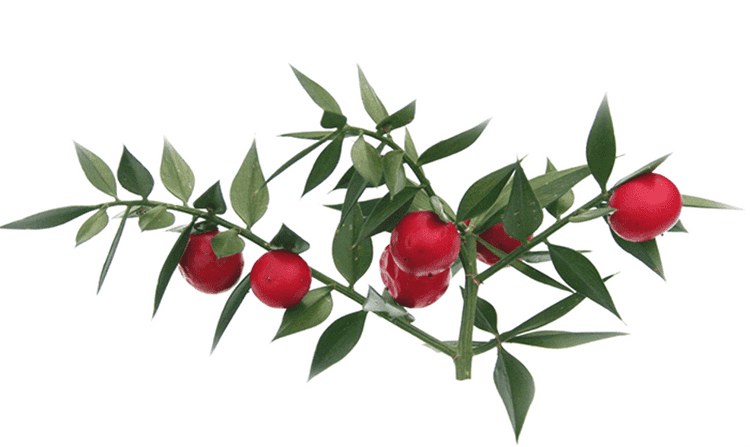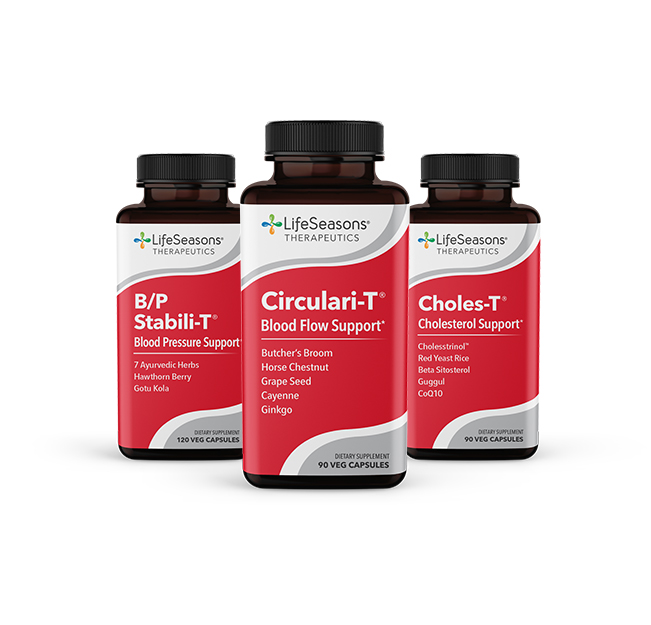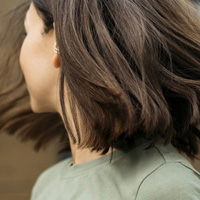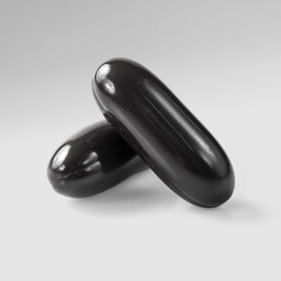BACKGROUND
Ingredient Type: Botanical, Extract
Also Known As: Ruscus aculeatus, Butcher’s broom root extract, Knee holly, Sweet broom, Box holly, Jew’s myrtle (1,2,3,4,5,6)

Ruscus aculeatus L., or butcher’s broom, is a green shrub native to Western Europe from the Liliaceae family. It is named butcher’s broom because the butchers in Europe used the stiff plant to clean their cutting boards (7). Compounds like ruscogenin and neoruscogenin have been isolated from the rhizome (the underground stem) in the twentieth century.
Butcher’s broom has been recommended in combination with aqueous extracts to adults in France since 1998 for hemorrhoid symptoms and for certain symptoms of chronic insufficiency (i.e. sensation of heavy legs). The 2003 monograph of the European Scientific Cooperative on Phytotherapy, the 2001 Commission E Monograph, and the 2007 information from the Federal Institute for Drugs and Medical Devices (Bfarm) recommend butcher’s broom for similar symptoms (8).
TRADITIONAL USES
Traditionally, butcher’s broom was used to relieve menstrual pains and as a diuretic. In ancient times in Europe, butcher’s broom was used to treat constipation, abdominal pains, and urinary disorders. The use of butcher’s broom became more prevalent in Germany in 1978 and in France in 1986 (8).
WHAT DOES SCIENCE TELL US?
Butcher’s Broom Might Support a Healthy Cardiovascular System:
The literature on the effect of butcher’s broom on symptoms of chronic venous insufficiency (CVI) is generally consistent with evidence supporting that butcher’s broom in combination with hesperidin methyl chalcone and ascorbic acid is able to relieve symptoms of CVI.
In a four-month study, 16.5 mg of Ruscus aculeatus, 75 mg of hesperidin, and 50 mg of ascorbic acid (a combination of the RAES capsule) were administered in forty subjects with venous disease in the lower limbs. Patients observed the effectiveness of the combination in improving symptoms of chronic phlebopathy of the lower limbs.
Butcher’s broom’s efficacy and safety have been investigated in a multi-center, double-blind, randomized, placebo-controlled study in patients with CVI. One forty-eight subjects (women with chronic venous insufficiency, 30-89 years, 150-182 cm height, 49-97 kg body weight) were divided into the supplemented with 36-37.5mg of a 15-20:1 concentration and the placebo group and participated in the twelve weeks of supplementation. The study concluded the efficacy of butcher’s broom (compared with placebo) to be significantly better. Butcher’s broom was able to reduce lower limb circumference and improve the global symptoms of subjects with CVI (9).
The effectiveness and tolerability extract of butcher’s broom was investigated in a four-month cross-over, double-blind trial in forty patients with a venous disease in the lower limbs. Subjects (females and males, 28 – 74 years old, with chronic phlebopathy of the lower limbs) were given 2 capsules, 3 times/day of a venotropic drug (RAES) which included an extract of 16.5 mg of Ruscus aculeatus, 75 mg of hesperidin, and 50 mg of ascorbic acid, or placebo (with 15 days interim period for wash-out). Post-assessment results showed an improvement tendency during the time of treatment with RAES noting an immediate significant change in symptoms and plethysmographic parameters (in particular MVIV 40 and 60). Butcher’s broom appeared to be safe and effective in improving symptoms of chronic phlebopathy of the lower limbs when administered with hesperidin and ascorbic acid dosages such as the RAES drug combination (10).
A meta-analysis investigated the combination of root extract of 150 mg per capsule of butcher’s broom, 150 mg of hesperidin methyl chalcone and 100 mg of ascorbic acid (Cyclo 3 Fort) in treating chronic venous insufficiency (CVI) in 10,246 subjects in twenty placebo-controlled, randomized, double-blind studies and 5 randomized studies beside a comparator drug. Six single arm Cyclo 3 Fort studies were reviewed alone with no placebo arm. Cyclo 3 Fort response was compared to the baseline. Post-assessment via a four-point symptom severity scale (0=no symptoms, 3=severe symptoms), the following results were revealed in the Cyclo 3.
The meta-analysis concluded the effectiveness of Cyclo 3 Fort which includes a combination of butcher’s broom, hesperidin methyl chalcone, and ascorbic acid, in significantly reducing the severity of the CVI symptoms (11).
The efficacy and tolerability of butcher’s broom in treating CVI of the lower limbs were investigated in a randomized, double-blind, placebo-controlled study in sixty patients with uncomplicated CVI. The subjects were given Cyclo 3 Fort, which is a combination of butcher’s broom, hesperidin methyl chalcone, and ascorbic acid in a form of two daily capsules for sixty days. Post-assessment results of the study revealed the following in the Cyclo 3 Fort group a significant symptoms’ decrease and regression and a reduction in lower limb circumference (measured at the ankle). The study concluded the effectiveness of butcher’s broom in combination with hesperidin methyl chalcone and ascorbic acid in treating subjects with uncomplicated venous-lymphatic insufficiency of the lower limbs (12).
Butcher’s Broom Possibly Supports Balanced Cholesterol and Blood Glucose Levels:
Only one study has been identified on the effect of butcher’s broom on HDL-C; as such, the evidence is inadequate. Replication would be necessary to confirm results.
The clinical effect of butcher’s broom extract, the buckwheat herb, and the troxerutin has been investigated in a three-month study in sixty patients with non‐proliferative diabetic retinopathy. Subjects were divided into three groups and given either 0.5 g of troxerutin (0-(beta-hydroxyethy1)-rutoside) twice daily, butcher’s broom (0.0375 g twice daily), or two tablets of buckwheat herb three times a day (1 tablet contains 0.5 g Fagopyrum esculentum herb and 0.03 troxerutin). Post-assessment results, specifically for butcher’s broom, revealed; an increase in the amplitude of oscillating potentials by 15%, a decrease in the blood serum concentrations of fructosamine by 7.8% (p<0.01), a decrease in HbA1c by 15.6% (p<0.001), a decrease in the mean blood serum concentrations of glucose by 10.6% (p<0.01), a drop in total cholesterol by 9.4% (p<0.01), an increase in HDL-C by 23% (p<0.001) (13).
While there was noted a regression of changes in the fundus of the eye in all patients (27.8%), progression was noted in the troxerutin group (5.6% of patients) and in the buckwheat herb (3.3% of subjects); however, in the butcher’s broom group cases with progression of abnormalities in the fundus of the eye were not noted; 23.1% of patients showed improvement. The study observed troxerutin to be less effective (especially in oscillating potentials) and it concluded the effectiveness of buckwheat herb to be used to treat and complete prophylaxis of diabetic patients who are suffering from retinopathy (13).
SAFETY
Butcher’s broom appears to be safe when used short-term in the aforementioned dosages (6,9,10,14). There isn’t sufficient evidence to support the safety of the ingredient during pregnancy and lactation.
Interactions:
Moderate
- Medications used for high blood pressure (Alpha-adrenergic antagonists) (6,9)
- Stimulant Medications (Alpha-adrenergic agonists)
Side-Effects:
- Gastrointestinal and epigastric discomfort (i.e. nausea, abdominal pain) (14,15)
- Can induce vasoconstrictive properties (dilate blood vessels); caution is advised for people with high blood pressure (6,10,12,14,16,17)
REFERENCES
- Ruscus aculeatus L. — The Plant List. The Plant List A working list of all plant species. http://www.theplantlist.org/tpl1.1/record/kew-286704. Accessed April 24, 2018.
- World Checklist of Selected Plant Families: Royal Botanic Gardens. Kew Science. http://wcsp.science.kew.org/namedetail.do?name_id=286704. Accessed April 24, 2018.
- Bylka W, Kornobis J. [Butcher’s Broom, in the treatment of venous insufficiency]. Pol Merkur Lekarski. 2005;19(110):234-6.
- Sannie C, Lapin H, Eloy F, Sanchez l. [Research on sterol sapogenins. VIII. Saponosides of butcher’s broom (Ruscus aculeatus L.)]. Bull Soc Chim Biol. 1957;39(2-3):301-11.
- Butcher’s Broom Uses, Benefits & Dosage – Drugs.com Herbal Database. Drugscom. https://www.drugs.com/npp/butcher-s-broom.html. Accessed April 24, 2018.
- Redman DA. Ruscus aculeatus (butcher’s broom) as a potential treatment for orthostatic hypotension, with a case report. J Altern Complement Med. 2000;6:539-549. doi: 10.1089/acm.2000.6.539
- Butcher’s Broom. Michigan Medicine University of Michigan. https://www.uofmhealth.org/health-library/hn-2058001#hn-2058001-related-information. Accessed June 18, 2018.
- Assessment Report on Ruscus Aculeatus L., Rhizoma. European Medicines Agency, Evaluation of Medicines for Human Use. http://www.ema.europa.eu/docs/en_GB/document_library/Herbal_-_HMPC_assessment_report/2009/12/WC500018288.pdf. Accessed April 24, 2018.
- Vanscheidt W, Jost V, Wolna P, et al. Efficacy and safety of a Butcher’s broom preparation (Ruscus aculeatus L. extract) compared to placebo in patients suffering from chronic venous insufficiency. Arzneimittelforschung 2002;52:243-250. doi: 10.1055/s-0031-1299887
- Cappelli R, Nicora M, Di Perri T. Use of extract of Ruscus aculeatus in venous disease in the lower limbs. Drugs Exp Clin Res 1988;14:277-83.
- Boyle P, Diehm C, Robertson C. Meta-analysis of clinical trials of Cyclo 3 Fort in the treatment of chronic venous insufficiency. Int Angiol. 2003;22(3):250-262.
- Parrado F, Buzzi A. A Study of the Efficacy and Tolerability of a Preparation Containing Ruscus aculeatus in the Treatment of Chronic Venous Insufficiency of the Lower Limbs. Clinical Drug Investigation, 1999;8(4):255.
- Archimowicz-Cyrylowska, B. Clinical effect of buckwheat herb, Ruscus extract and troxerutin on retinopathy and lipids in diabetic patients. Phytotherapy Res 1996;10:659-662.
- Beltramino R, Penenory A, Buceta AM. An open-label, randomized multicenter study comparing the efficacy and safety of Cyclo 3 Fort versus hydroxyethyl rutoside in chronic venous lymphatic insufficiency. Angiology 2000;51:535-44. doi: 10.1177/000331970005100702
- Blumenthal M, Busse WR, Goldberg A, et al. (eds). The Complete Commission E Monographs: Therapeutic Guide to Herbal Medicines. Boston, MA: Integrative Medicine Communications, 1998, 99-100.
- Jager K, Eichlisberger R, Jeanneret C, Lobs KH. Pharmacodynamic Effects of Ruscus Extract (Cyclo 3 Fort) on Superficial and Deep Veins in Patients with Primary Varicose Veins: Assessment by Duplexsonography. Clinical Drug Investigation 1999;17(4):265.
- Miller VM, Rud KS, Gloviczki P. Pharmacological assessment of adrenergic receptors in human varicose veins. Int Angiol. 2000;19(2):176-183.
See the Examine.com entry for Ruscus aculeatus, the WebMD entry for butcher’s broom, or the Michigan Medicine Health Library entry for butcher’s broom for more information.









